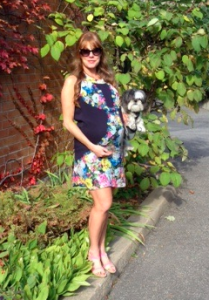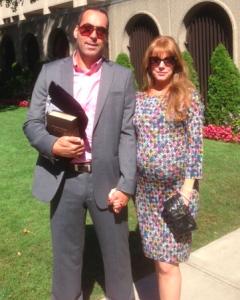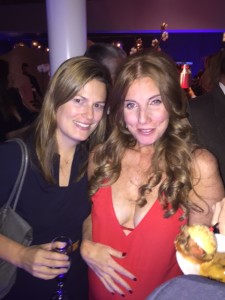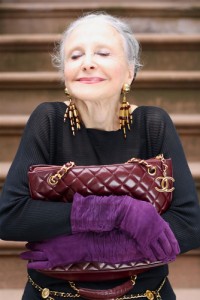*Story appeared in Huffington Post Canada.
 Fancy-dancy baby bumps are all the rage, especially among the celeb set. And when I first got pregnant, it felt like Kate, Kim et al. were staring me down from the grocery aisles. Goading me into joining the fun.
Fancy-dancy baby bumps are all the rage, especially among the celeb set. And when I first got pregnant, it felt like Kate, Kim et al. were staring me down from the grocery aisles. Goading me into joining the fun.
But nay, I thought in protest. Maternity fashion was vanity gone haywire. Yeah, yeah, I loved dressing-up more than pretty much everyone I knew, but suction tight maternity dresses and bikini-clad #babybump selfies seemed to be crossing a line. The message: Women should (should! Bwa-haw-haw!) look their best always–before and after their water broke.
So I had a revelation, “I am going to let myself go!”–for those nine months. I would allow my body to roar au naturel. Also, to help combat wasteful capitalism–which I myself was often guilty of–I refused to buy a whole new maternity wardrobe. I was bringing a new life into the world, after all. It was time to be practical, ethical. Maybe I’d purchase some elastic-waist jeans, leggings, a few tops, but that was it.
For a few months, I lived on as this low-maintenance person. I wore whatever fit in my closet. I felt, um, good. Relaxed. “No nausea,” I reported to anyone who’d listen, as if this reflected my even keeled psychological state.
But by month five even my husband’s button downs were splitting on me like sausage casings. Still, half-imagining myself to be practical, I decided to buy large sized normal pieces (read: non-maternity) that I could re-wear postpartum, say with a belt.
Sweats weren’t exactly versatile. Rather, I needed just a few key outfits that could work from day to night–especially night. A pink A-line dress, a white kaftan, and a silky maxi soon followed. I brought them to my tailor, since roomy regular clothes don’t quite fit the way proper maternity ones might. A slit here and a plunging neckline there guided the eye just so–as in, away from my swollen hips and legs, and the grim-reaper veins on my ankles and hands.
True, it was all a tad indulgent, but overall, my plan still erred on sensibility. Or so I told myself.
I wore my new white kaftan for my stroll to the coffee shop. Compliments ensued, from baristas, from people on the street. “Hey hot mama,” a passenger hooted out a car window.
Did you say “hot mama?” Far from offended, the praise went down better than my vanilla Frappuccino–a wild declaration for this pregnant chick to make. And though the tiny growing baby inside couldn’t hear their words, I imagined he or she was feeding off my buzz. And that was when it occurred to me: My low-maintenance days were probably over.
“Wow, you look lovely,” my husband nuzzled into my neck. I had on the kaftan again, since I only had three outfits. But this time I wore it with wedges. And I got a blow out. Because it was near-impossible to flip over for my hair dryer with my gut.
Oh, yeah! Full of hormones, and knowing that the numbers on my scale were dashing up the ranks, the flattery made me feel like I was a star of some kind–even if just the star of my own life. Finally. After nearly two decades of agonizing dating, all that studying and working and weighing my talents against a tanking market–then to at last to find my love, get married, I finally, finally became pregnant!
And I was fancy!
I stormed back to my genius tailor, Hussein Padar, with a new python maxi, a khaki tunic, two navy print dresses, another kaftan, and a red spaghetti strap number. I bought them mostly on sale, mostly online. A few were donated from friends. Et voila. After his strategic sewing, I had a made-to-measure maternity wardrobe. Here I come! I mean, here we come.
Yet with each decadent step forward, my guilt followed. It wasn’t so much about spending money, because I knew I’d re-wear most things post-partum. Rather, I felt like I was endorsing the position that expecting women couldn’t take a frump day–that regardless of their health, wealth, or state of mind, women had to be attractive at all times.
But did I need to be a sex object 24/7 to the horrors of my internalized Gloria Steinem (pre-Sanders women-bashing Steinem, that is)?
Um, apparently.
Because I loved the praise–especially since every other person seemed to wonder if I was carrying twins, which I wasn’t (“are you sure?”). And I wasn’t covering up my stomach with a muumuu as pregnant women did decades ago. Instead, I was felt like shining at 150-plus-plus-pounds and with a 40-plus-plus-inch waist. At age 30-something, yet. I was a soon-to-be mom, not a teeny twenty-something we’re led to believe is the pinnacle of beauty, and I felt terrific. Curvy.
Most importantly, I had this telekinetic belief that adorning my bump was introducing my growing baby to the splendors of life, like flowers and artwork.

A second thought settled in: Maybe maternity fashion wasn’t the devil incarnate after all; maybe there was something glorious about all these proud mommies grooming themselves and their young to be — and trying to attract their mates, despite having already mated. And if this amounted to celebs flaunting bandage dresses and crop tops with their blossoming midriffs, so be it. All this excess could be evidence of a good thing. The best thing.
It was now obvious to me: #babybump signaled that a new rounder, more maternal beauty standard was finally en-vogue. I had to raise my half-filled champagne glass to that.
So, during my recent second pregnancy, it was time for my sequel performance. My costumes were pressed and ready to go. As I waddled about with my beach ball stomach that held my 10-lb baby.
“You’re HUMONGOUS!” they cried.
Oh yeah! Bring it on. I took plenty of pics this time.
–SUZANNE WEXLER

 Paris Fashion Week from Elle.com
Paris Fashion Week from Elle.com